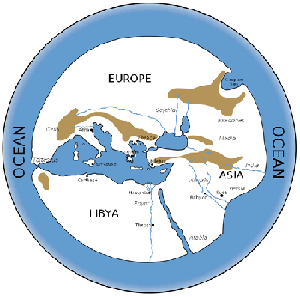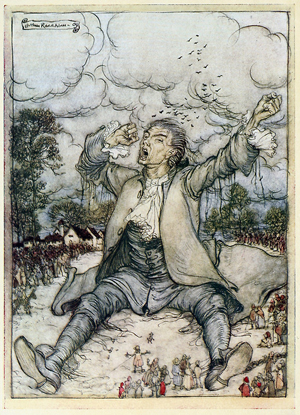Origins of Science Fiction

Speculative and fantasy fiction has a long history. The early Greeks were entertained by epic poems about various gods, monsters, and fantastic voyages to far-off worlds. Jason's journey aboard the Argo took place in the Mediterranean, but could equally have happened in deep space. Jason (guided by a talking beam built into the Argo which could represent an early prototype of HAL or Mother) captained his ship and crew through encounters with incredible creatures such as the Gegenees (six-armed giants), the Clashing Rocks, the Stymphalian Birds (possessing feathers made of pointed bronze), and warriors that sprang from dragon's teeth planted in the soil.
These fantastic fables were used as entertainment, as a way of accounting for natural phenomena (what better way to explain a whirlpool than to imagine a sea monster at its root?), and as a way of integrating religious beliefs into everyday experience. The marvelous was equated with the miraculous, and attributed to a divine or supernatural origin via a myth.
In the centuries that followed, fiction kept pace with scientific and geographic discoveries. There were still sea monsters, giants and dragons, but each European voyage of discovery pushed their existence further and further beyond the expanding boundaries of the known world. Scientific investigations toppled myth after myth, as men like Copernicus and Gallileo challenged centuries-old beliefs about humans' place in the universe. This gave rise to an increase in fantasy fiction, about voyages to the Moon instead of across the Mediterranean; these tales had a wholly different resonance after the invention and development of the telescope in the early 17th century, which enabled astronomers to map the lunar surface (and conjecture what might be living in the mountains and seas that they thought they saw).
Although the term 'science fiction' didn't come into use until the mid-19th century, there are several important works published before then that can lay a claim to being part of the genre, proto sci fi — they have certainly had a significant influence upon it.
Thomas More - Utopia (1516)
Sir Thomas More was an important politician during the reign of Henry VIII of England. During his lifetime he was appointed as Lord Chancellor, despite his staunch Catholicism, and he was eventually beheaded for his beliefs, in 1535. He was canonised by the Catholic Church in 1935, and recognised as a 'saint and hero' by the Church of England in 1980.
However, his religious background belies his main contribution to Western culture. He is most remembered as a social philosopher, and for coining the word 'utopia', the title of his Latin polemic published in 1516. His seminal book identified the malaise in European society (he blamed poverty brought on by the enclosures) and envisioned the perfect alternative, an island society based on principles of equality, shared ownership and productivity, named Utopia. For such a devout Catholic, his theories that divorce, euthanasia, and multiplicity of religious beliefs would form the basis of an ideal society come as something of a surprise, as does his support of married and female priests. It has been suggested that Utopia was primarily a satire, More's way of swiping at the tide of Reformation thinking that threatened (from his Catholic perspective) to engulf European sanity.
Whatever More's intent, his book has become a paradigm of science fiction, with many authors subsequently envisioning their own alternative social systems, often on an island, or the space travel equivalent, a far-off planet. The word utopia came to represent an ideal way of living, particularly an unachievable or ironic set of principles. The word 'dystopia' was first used by John Stuart Mill in 1868, to describe the UK government's Irish policies, but the concept of an 'anti-Utopia' has since become fundamental to sci fi depictions of future worlds.

Jonathan Swift - Gulliver's Travels (1726)
Swift was a theologian, harshly critical of English and Irish politics in his day, who, despite having no formal scientific training, was well aware of how technology could have an impact on society. Although ostensibly a satire in the Horatian mode (it was originally published anonymously, with ‘Lemuel Gulliver’ listed as the author), Gulliver's Travels is a vehicle both for flights of fantasy, and for satirising what Swift perceived as the social ills of his day. As with the best science fiction, Swift creates a complex, detailed alternate reality, refracting contemporary politics and scientific knowledge through his creative lens. He situates his hero very much in the known world, providing maps so his reader can locate Lilliput and Blefescu near Sumatra, and Houyhouhm Land next to Alaska. The narrator adopts an investigative, anthropological approach, serving up observations and statistics in order to educate the reader – in the typically preachy tone of travel writing of the day. Gulliver's Travels contains references to many fantastic inventions and social innovations that seemed impossible in the early 18th century, but have since found their way into science fact.
On his travels, Gulliver encounters one man engaged in bio-energy experiments, who'd spent "eight years upon a project for extracting sunbeams out of cucumbers, which were to be put in phials hermetically sealed, and let out to warm the air in raw inclement summers. He told me, he did not doubt, that, in eight years more, he should be able to supply the governor's gardens with sunshine, at a reasonable rate". Another professor has invented a knowledge engine (the precursor of crowd-sourcing?) whereby an elaborate contraption links "bits of wood [which] were covered, on every square, with paper pasted on them; and on these papers were written all the words of their language, in their several moods, tenses, and declensions; but without any order". Thirty six of the professor's students turn handles to produce word sequences, and the other four scribe the results. Gulliver is also rather startled when the sun is blocked out, for a few minutes, by Laputa, "an Island in the Air, inhabited by Men, who are able (as it should seem) to raise, or sink, or put into a Progressive Motion, as they pleased."
Gulliver's Travels was an immediate success on publication, and has never been out of print since. Swift's astute assessment of the more ludicrous (and morally offensive) elements of his own society and his ability to extrapolate those into comic, exaggerated scenarios, has never lost its resonance or its broad appeal: there have been several successful movie adaptations of the book, proving that the storytelling still chimes with audiences nearly three centuries later. While Gulliver's Travels comes too early to be considered "true" science fiction, it has definitely provided the prototype for many subsequent authors within the genre.
Mary Shelley — Frankenstein (1818)
The first book to adopt a truly scientific approach to fiction is Mary Wollstonecraft Shelley's Frankenstein or, The Modern Prometheus. The book's genesis is well known; a group of poets, artists, leading Romantics, challenge each other to write a horror story one dark and stormy night at the Villa Diodati, and in doing so a teenage girl makes literary history.
Frankenstein is an innovative book for several reasons. Shelley strips her speculative fiction of all but the most essential fantasy elements, and structures her narrative within a realistic mode of storytelling. Although she namechecks a character from Greek mythology in her title, Shelley is the first writer to move beyond the 'fantastic voyage' for her sci-fi construct. Events don't take place on some fictional island but in real locations across Europe. The monster, far from being a fabulous creature, is recognisably, grotesquely human, the sum of body parts rather than a supernatural creation. The supporting characters are ordinary people who move through the story according to the constraints and mechanisms of contemporary society - they don't have any special machines or powers that will help them combat the monster. Instead of creating an alternate world, she alters a single crucial element within our known existence, and explores the ramifications, the classic "what if...?" scenario that has since become a standard paradigm for the genre.
Shelley's narrative stems from a central scientific innovation, based on what she had read of experiments in galvinism (favorite of high school biology labs today, but an innovative concept at the time), but, like Swift, she extrapolates the known facts into fictional terrain. Frankenstein is social critique, prophecy and warning all rolled into one. In one sense, the novel is rooted in Romanticism with its focus on the primal, and sacrilegious urge of one man to become a god by harnessing the raw power of nature. However, it had, and continues to have, one eye on the future, as discoveries within biology and genetics lead us ever closer to the point where human life can be created within a laboratory.
Like Gulliver's Travels, Frankenstein continues to be adapted into movie versions for successive generations. The first movie adaptation of the book appeared in 1910.
Science Fiction becomes a genre
The term scientist first appears in 1834, coined by the Master of Trinity College, Cambridge, William Whewell. He was looking for a term to replace labels like 'natural philosopher', or the German term “naturforscher”, and decided on scientist as a direct parallel to artist. At that point in history, science was as much a process of creation and innovation as it was of investigation, and Whewell felt that scientists and artists had much in common. During the Romantic era (1770-1840), poets and natural philosophers did indeed share a fascination with the workings of the world around them, and were in the habit of engaging with, and critiquing, each others' work. Interest in the natural world coincided with the increasing reliance of society on technology. Given that scientists, poets, philosophers and visual artists all moved within the same social strata in big cities, it was inevitable that their ideas and beliefs would meet and mesh at dinner parties, salons, balls and coffee houses, anywhere where intelligent discussion was the order of the day.
It was therefore no great leap from the idea of scientists, who specialised in investigating and analysing and hypothesising about the world around them, to the concept of science fiction, a methodology of thought that includes fantasy and conjecture as well as the facts being discovered by the scientists. This term first appears in 1851 (in Chapter 10 of William Wilson's A Little Earnest Book upon a Great Old Subject): "Science-Fiction, in which the revealed truths of Science may be given interwoven with a pleasing story which may itself be poetical and true." From here on in, science fiction becomes a label for novels and short stories that deal in alternatives to realism or history, and are distinct from the fantasy and horror genres.
Nineteenth Century Science Fiction
- The Huge Hunter,or The Steam Man of the Prairies (1868) Edward Ellis
- Journey To The Centre of the Earth (1871) Jules Verne
- Erwhon(1872) Samuel Butler
- The Strange Case of Dr. Jekyll and Mr Hyde (1886) Robert Louis Stevenson
- A Connecticut Yankee in King Arthur's Court(1889) Mark Twain
- The Island of Dr Moreau (1896) H.G. Wells
Further Reading
- How The Word Scientist Came To Be—NPR interview with Dr Howard Markel
- When Science And Poetry Were Friends — New York Review of Books
- Science Fiction:The Early History— H. Bruce Franklin
- Brian Aldiss on Frankenstein
